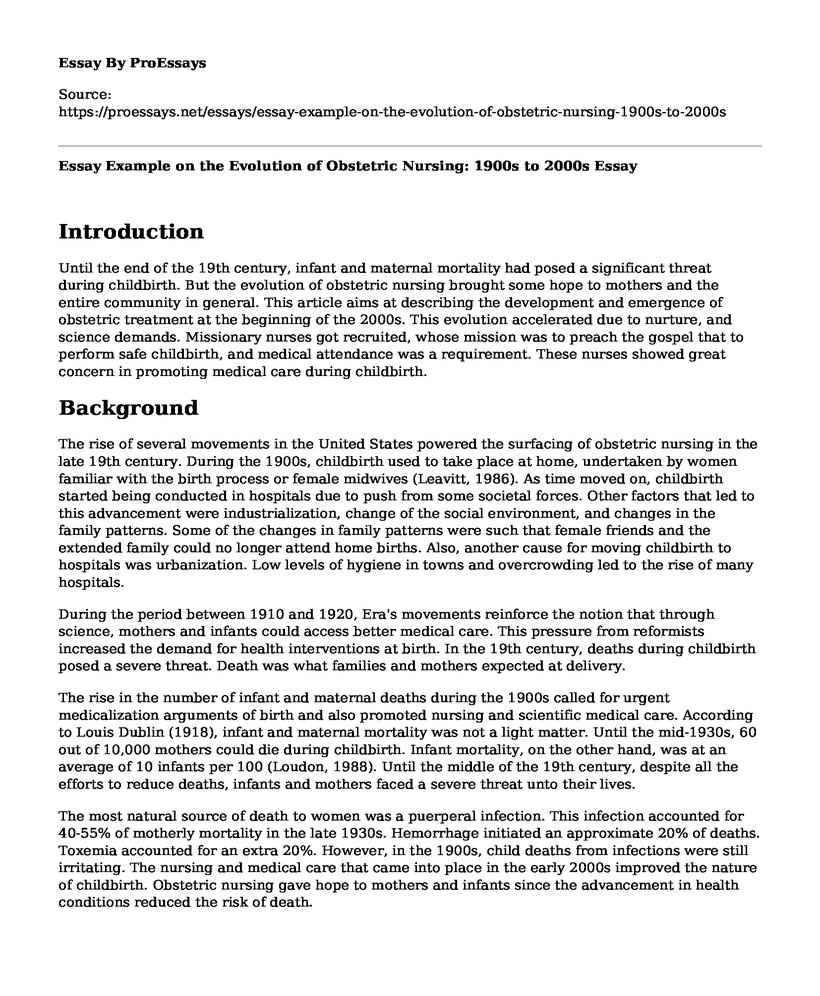Introduction
Until the end of the 19th century, infant and maternal mortality had posed a significant threat during childbirth. But the evolution of obstetric nursing brought some hope to mothers and the entire community in general. This article aims at describing the development and emergence of obstetric treatment at the beginning of the 2000s. This evolution accelerated due to nurture, and science demands. Missionary nurses got recruited, whose mission was to preach the gospel that to perform safe childbirth, and medical attendance was a requirement. These nurses showed great concern in promoting medical care during childbirth.
Background
The rise of several movements in the United States powered the surfacing of obstetric nursing in the late 19th century. During the 1900s, childbirth used to take place at home, undertaken by women familiar with the birth process or female midwives (Leavitt, 1986). As time moved on, childbirth started being conducted in hospitals due to push from some societal forces. Other factors that led to this advancement were industrialization, change of the social environment, and changes in the family patterns. Some of the changes in family patterns were such that female friends and the extended family could no longer attend home births. Also, another cause for moving childbirth to hospitals was urbanization. Low levels of hygiene in towns and overcrowding led to the rise of many hospitals.
During the period between 1910 and 1920, Era's movements reinforce the notion that through science, mothers and infants could access better medical care. This pressure from reformists increased the demand for health interventions at birth. In the 19th century, deaths during childbirth posed a severe threat. Death was what families and mothers expected at delivery.
The rise in the number of infant and maternal deaths during the 1900s called for urgent medicalization arguments of birth and also promoted nursing and scientific medical care. According to Louis Dublin (1918), infant and maternal mortality was not a light matter. Until the mid-1930s, 60 out of 10,000 mothers could die during childbirth. Infant mortality, on the other hand, was at an average of 10 infants per 100 (Loudon, 1988). Until the middle of the 19th century, despite all the efforts to reduce deaths, infants and mothers faced a severe threat unto their lives.
The most natural source of death to women was a puerperal infection. This infection accounted for 40-55% of motherly mortality in the late 1930s. Hemorrhage initiated an approximate 20% of deaths. Toxemia accounted for an extra 20%. However, in the 1900s, child deaths from infections were still irritating. The nursing and medical care that came into place in the early 2000s improved the nature of childbirth. Obstetric nursing gave hope to mothers and infants since the advancement in health conditions reduced the risk of death.
Conclusion
This document at first explains the nature of childbirth in the United States in the early 1900s. Then it describes how birth took place, and the advancement of health at the time. Also, it sites scholarly who helped in understanding the emergence of obstetric nursing. Finally, the paper gives some data confirming the effects of infectious diseases that caused infant and maternal deaths before medical evolution.
References
Dublin, L. I. (1918). The Mortality of Childhood. Quarterly publications of the American Statistical Association, 16(121), 921-945.
Leavitt, J. W. (2016). Brought to bed: childbearing in America, 1750-1950. Oxford University Press.
Loudon, I. (1988). Maternal mortality: 1880-1950. Some regional and international comparisons. Social history of medicine, 1(2), 183-228.
Cite this page
Essay Example on the Evolution of Obstetric Nursing: 1900s to 2000s. (2023, Apr 24). Retrieved from https://proessays.net/essays/essay-example-on-the-evolution-of-obstetric-nursing-1900s-to-2000s
If you are the original author of this essay and no longer wish to have it published on the ProEssays website, please click below to request its removal:
- Health Policy and Regulation Issues - Essay Sample
- How Diseases Affect The Population Paper Example
- Essay on Causes of Obesity in Children
- Reflective Essay on 14 Years of Emergency Nursing: Challenges, Coping and More
- Paper Example on Contingency Planning: Ensuring Employee Safety in Emergencies
- Essay on New Parents' Decisions on Vaccination: Study at Yale's New Haven Hospital
- Essay Sample on Modern Healthcare: CEOs Facing Strict Measures to Meet Medical Demands







